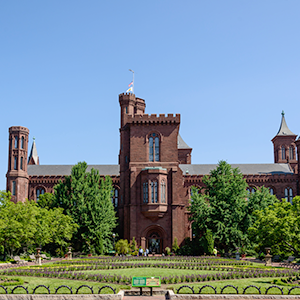The Enid A. Haupt Garden is one of the most famous landmarks at the
Smithsonian Gardens. Looking straight outward, the landscape creates a
diamond of various purple flowers. There’s a vastness of green that takes
both the perimeter and area of the diamond, accompanied by white trees that
lead to a grand castle at the top of the walk. It carries a pristine red
look as if from medieval times, and gray roofing with individual towers
that have roofs shaped like tops.
There’s more to experience than solely the garden, though. Individuals can
treat themselves to the events and educational activities at the
Smithsonian Gardens. According to its website, the Smithsonian Gardens’
mission statement is to extend a typical “museum experience” into an
outdoor classroom full of life. With these kinds of programs, the gardens
can help expand knowledge of our natural world and make it transferable
into everyday life.
Garbage to Gardens is a set of lessons at the gardens to teach students
about a recycled garden. The program focuses on sustainability, which
includes water conservation, recycling and natural gardening techniques.
The students work hands-on in activities like creating compost and
discovering the amount of available water on Earth. The aim is for students
to be conscientious of their surroundings and to understand how they can
play a positive environmental role. One activity, known as Don’t Pitch It,
Plant It!, involves showing how potato plants grow and how people can work
to compost with kitchen scraps and old produce.
Trees of the Smithsonian is another program which helps teach students how
to incorporate trees into their curriculum, like English or Science. One
activity, called Trees of Significance, demonstrates concepts of meaning
and representation. For example, a red oak tree known as the Medal of Honor
near the American Museum of National History commemorates U.S. war veterans
who received the Medal of Honor, the most prestigious award bestowed upon a
member of the Armed Forces. Its symbolism as a tree is that it was the
first design for the medal, and today recipients also obtain a cluster of
oak leaves and acorns on the medal. This latest tree, planted in 2010,
includes soil collected from 16 battlegrounds to represent the 11 wars the
United States has fought.
Orchids around Us is a package that enhances the gardens’ collections by
making them universally accessible beyond the museum. One activity known as
Large Family, Small Start teaches students how large the orchid family is
and how small its seeds are. Orchids, according to the website, “are the
largest family of flowering plants” with roughly “25,000 species of orchids
that occur naturally.” They have some of the world’s smallest seeds. The
only organism that has more species than the orchid is fish, which contains
roughly 32,000 species in its family.
The website (gardens.si.edu/our-gardens/haupt-garden.html) also contains
some videos to show off specific aspects of the garden. One example is a
video that showcases the various orchids and how many exist in different
shapes and forms. One favorite is a yellow orchid with black and orange in
the center of the plant, with petals that appear sharp but are skinny and
long.
The way to determine what’s in bloom is by smelling and observing the
flowers themselves. One orchid has an aroma similar to chocolate.
Beyond being natural spectacles that aim to preserve biodiversity, the
Smithsonian Gardens are a chance to branch out for multiple interests.
Whether it be in the classroom or in the gardens themselves, there are
plenty of ways to engage and learn more about the world around us and how
we can preserve it.

